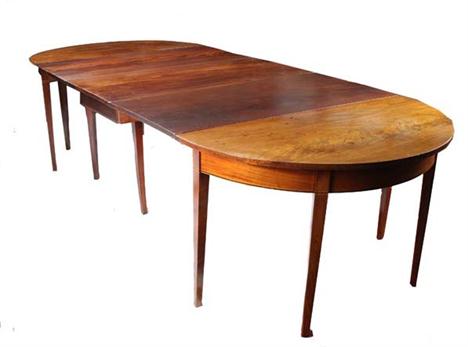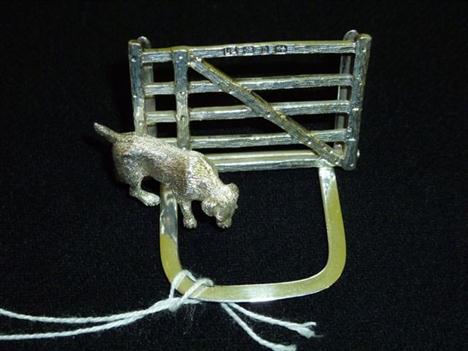We found 48015 price guide item(s) matching your search
There are 48015 lots that match your search criteria. Subscribe now to get instant access to the full price guide service.
Click here to subscribe- List
- Grid
-
48015 item(s)/page
Rare 1945/46 Wigan v Huddersfield rugby final pirate programme – played at Maine Rd Manchester on 18th May 1946 – usual pocket folds and score to the centre page (f) – note this game broke the world record for gate receipts of no. 8387 and just failed to break the record attendance (held by Australia 70,204) with 67,136
Four: Captain Stuart Duncan, Gloucestershire Regiment, who was killed in action at Hooge on 13 November 1914 whilst attached to the Middlesex Regiment Queen’s South Africa 1899-1902, 3 clasps, Natal, Orange Free State, Transvaal (Capt., Glouc. Rgt.); 1914 Star, with clasp (Capt., Glouc. R.); British War and Victory Medals (Capt.) nearly extremely fine (4) £600-800 The following is extracted from The Bond of Sacrifice, Volume I: ‘Captain Stuart Duncan, Gloucestershire Regiment was killed in action at Hooge on the 13th November 1914. He was born in London in 1865 and educated at Marlborough College, and obtained his commission in 1884, becoming Captain in 1891. With his regiment he served in the South African War, taking part in operations in Natal, including actions at Rietfontein and Lombard’s Kop, where he was slightly wounded. He was also at operations in the Transvaal and Orange River Colony. In 1904 Captain Duncan left the Army and joined the Reserve of Officers, Gloucestershire Regiment. He had therefore been retired from the active list for ten years when the Great War broke out, but at once patriotically volunteered for active service, and was posted first to the 3rd Battalion of his old corps, from which he was sent out to the 2nd Battalion, South Lancashire Regiment at the front, but when killed was serving with the 4th Battalion, Middlesex Regiment. He behaved with great gallantry during the war, particularly on the day of his death, when he had been ten days in the trenches, continually shelled, and was shot down while leading his men, by whom he was specially beloved.’ Captain Duncan is listed in the Boer War casualty roll as being taken prisoner at Farquar’s Farm on 30 October 1899 and subsequently released. He has no known grave and his name is commemorated on the Ypres (Menin Gate) Memorial, Belgium. Sold with copy m.i.c.
Pair: Navigating Lieutenant T. E. B. Cope, Royal Navy New Zealand 1845-66, reverse dated 1863 to 1864 (Mr. Thos. E. B. Cope Master’s Asst. H.M.S. Miranda); Ashantee 1873-74, no clasp (Navg. Sub Lt. T. E. B. Cope, R.N. H.M.S. Argus. 73-74) minor edge bruising, otherwise good very fine (2) £800-900 Thomas Edward Butcher Cope was born on 1 May 1847, and joined the Royal Navy as a Master’s Assistant aboard H.M.S. London on 11 March 1862. Whilst Master’s Assistant aboard H.M.S. Miranda, which ship he joined in October 1863, he was landed with the Naval Brigade in New Zealand and was present at the attack on Gate Pah, &c. (New Zealand medal). Cope was Navigating Sub-Lieutenant of H.M.S. Argus during the Ashantee war of 1873-74 and was promoted for services during the campaign (Medal). Lieutenant Cope died on 29 July 1882, whilst serving at sea aboard H.M.S. Urgent.
An Edwardian, pearl, gold and platinum bracelet, circa 1910, set along the length with 3.5mm pearl spacers between gold scrolled gate style links and platinum curb link connections, to a concealed box snap clasp, 18cm long, 15g gross. Please note the pearls are untested and unwarranted as natural pearls
CHURCHILL, Winston S. (1874-1965). Two typed letters signed ('Winston S. Churchill', 'W.S. Churchill') to Dr James Senn, 28 Hyde Park Gate, 1 September and 21 October 1946, thanking him for a gift of some butter, noting that he himself keeps Jersey cows and is 'much interested in the manufacture of butter', and asking to to hear more about Senn's 'Co2 machine'; in the second letter, having seen further details of the machine, he notes that 'At present in England no-one is allowed to make butter for sale, but only for personal use'; he believes however that Senn's machine could 'play a growing part in agricultural economy' as normal conditions are restored, together two pages, 4to, framed and glazed. Butter rationing in the United Kingdom did not end until May 1954. (2) View on Christie's.com
A collection of assorted coral items, to include an early Victorian coral necklet centrepiece with three coral clusters of oval and bouton shaped coral cabochons with nine graduated coral pippin drops, a matching coral box clasp (no tongue), a single matching earring with coral pippin drop, a pair of carved coral cufflinks, a row of beads, part of a carved coral gate bracelet, numerous beads and fittings, and an unmounted natural coral twig (qty)
A George IV silver gilt snuff box, by Ledsam, Vale & Wheeler, Birmingham 1829, of engine turned rectangular form with foliate borders, the hinged cover engraved and enamelled with the Arms of the Dover, 8.5cm by 5.5cm by 2cm, 5.5oz The Arms are in trefoil form. At the top they contain a shield bearing the Arms of the Cinque Ports, beneath this are devices copied from the seal of the Borough dating from 1305 and below is a ribbon bearing the words ‘Ville-et-Portus-Dover’. (Town and Port of Dover). The Cinque Port Arms show the front halves of the three lions from the Arms of England joined to the back halves of three ships. Dover District Council has adopted a variant of the Cinque Port Arms. The device on the lower left hand side of the Dover Arms is taken from the front of the Corporate Seal and shows a mediaeval Cinque Ports ship believed to date from around 1284. The device on the lower right-hand side is from the reverse of the Seal and represents the legend of St Martin of Tours, the Patron Saint of Dover. St Martin is shown on horseback dividing his clock with his sword for the poor man he meets outside the city gate of Amiens. The Arms of Dover were used by the Borough of Dover until Local Government Reorganisation in 1974. After this, they were used by the Charter Trustees of Dover until 1996, when they were adopted by the newly formed Dover Town Council.
A small quantity of silver and white metal jewellery, to include a silver purple paste set thistle design brooch, a Scandinavian silver cabochon amethyst set abstract oval brooch marked E From, a silver gate bracelet, a silver thistle design ring and various other items. Condition: Due to the large quantity of items in this lot we are unable to provide a condition report.
An Edwardian 9ct gold gate bracelet, of six bar design with interspaced scroll embossed links and padlock clasp. Hallmarks for Birmingham 1909. Weight 20.21gms.. AF. Condition: The bracelet is in overall poor condition. Many of the bar links are dented off shape and dented inwards. There are slight scratches to the bar links and padlock in keeping with the age of the piece.
A mid 20th century gate style bracelet of brick link design with 9ct gold padlock. Length 19cms, weight 14gms. Condition: The bracelet is in overall good to fair condition. Many of the links are damaged. Most are bend out of shape. Several areas of sol;ft solder can be seen to the smaller links. Light scratches, bruising and dents can be seen, general wear.
-
48015 item(s)/page




















































